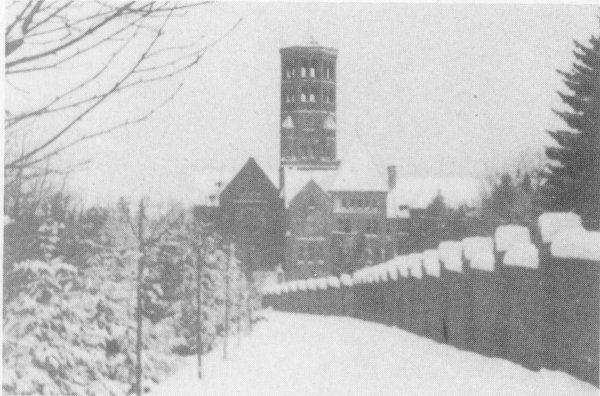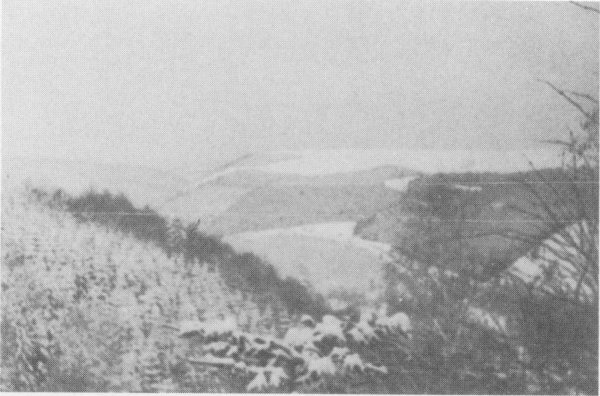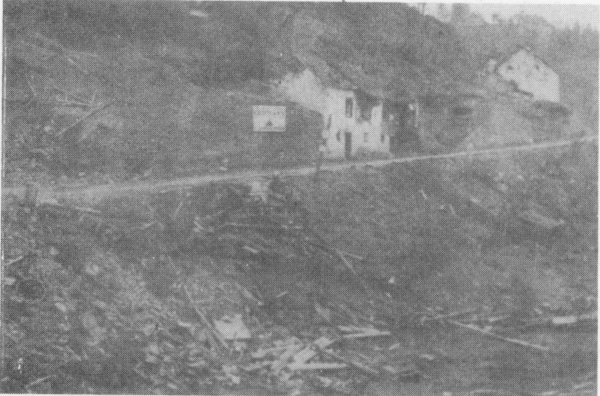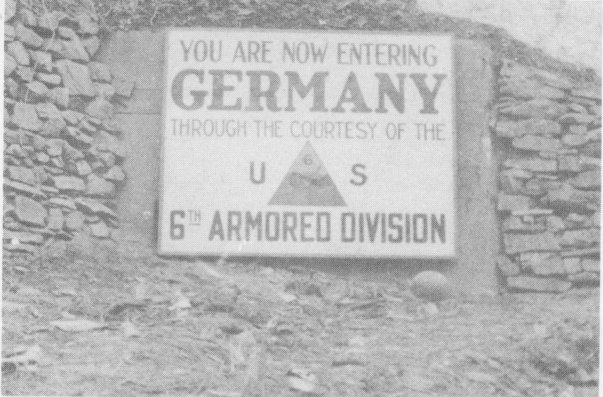 Bastogne |
 Table of Contents |
 To the Rhine |
 Bastogne |
 Table of Contents |
 To the Rhine |
The 212th left Weiler at 0900 the 27th and occupied positions around massive Abbe' de St. Maurice, a famous Luxembourg monastery a half mile northwest of Clervaux; battalion headquarters occupied the abbey itself. Tactical activity during all of the battalion's eleven-day stay there was very light, and practically no firing was done either while the mission was direct support of forces on the line or general support of the division; the Germans were complacently settled behind their vaunted Siegfried Line, and the division was content merely to watch them from its positions along Sky Line Drive, a Luxembourg main highway that ran north and south along a commanding ridge midway between the Clervaux River and the German-Luxemhourg border.

The battalion busied itself mainly with rest, rehabilitation, and recreation. On January 31, a unit rest center was organized in Nobressart, Belgium, five miles northwest of Anon, and a third of the battalion at a time was sent there for three-day periods of relaxation. General Grow took advantage of the lull in hostilities to pay the battalion two more visits to present awards. On January 29 he presented the Silver Star to Lt. Edward B. Ledford for gallantry in action as a forward observer during the last leg of the Saar drive. The same day Oak Leaf Clusters to Bronze Stars already received were awarded to Lt. Col. Pope for meritorious service in the Saar and at Bastogne, and to the Battalion Medical Officer, Capt. William J. Weaver, for heroic action near Ippling, France. And for extended meritorious service the general presented Bronze Stars to Capts. Winthrop S. Jameson, Jr., A Battery Commander, Robert W. Baker, Battalion S-2, Frank J. Lee, B Battery Commander, and Frank K. McDowell, Battalion' Motor Officer; Lt. Harold P. McAnally, Tec. Sgt. Joseph R. Keefe and Tec. 4 Lionel A. Lawrence, Headquarters Battery; Tec. 4 Nicolas Rome and Tec. 5 Deodato Medeiros, Battery A ; and Tec. 5 Charles H. Melvin, Battery C. On January 31 General Grow returned to present Pfc. Henry A. Marshall, Headquarters Battery, the Bronze Star for meritorious service.
On February 7 the battalion moved north some seven miles to Breidfeld in preparation for the division's first participation in Third Army's famous "active defense". The Sixth's mission was to cross the Our River on the German- Luxembourg border, and breach the Siegfried Line. The 212th was in Reserve Command on the north flank of the division, and in direct support of the 44th Infantry Battalion. The crossing was to be made after dark the 7th; it was begun on schedule, but the pitch blackness of the night and tbe swift current in the Our River forced the infantry to turn back after reaching the river. The next night, February 8, the crossing was attempted again, and one company was successful. During the day February 9 the second and third companies crossed the river, and the first belt of the Siegfried was reached, but the ferocity of the German resistance that followed, particularly in the form of artillery and mortars, made the bridgehead virtually untenable, and it was abandoned when the division's mission reverted again to holding. Battalion fires in support of the bridgehead operation were comparatively light, because of the limited observation available to the observers with the crossing forces.

On February 11 the Sixth Armored Division was assigned the mission of holding again along the Our River in a zone to include its present one and an area to the south, then held by the 17th Airborne Division, which it was to relieve. The 212th became a part of Combat Command A in the southern sector, and accordingly moved south through Clervaux to positionsaround Bockholz. The battalion 5 mission was direct support of the entire combat command, which was employing four battalions on the line to cover its sector; so in reality the mission became direct sup- port of four separate battalions. The resultant observer require. ments were the 212th's most extensive during the entire war. At one time seven observers and four liaison officers were used. To enable it to fulfill its multiple mission, the battalion was reinforced by two medium artillery battalions and the assault gun batteries from two tank battalions; fire direction center took on the nature of a group headquarters. The communications network required by these extensive activities was also the largest the battalion was ever called upon to establish; sixty miles of wire was used. For all of the nine-day holding period, however, the battalion's firing was comparatively light, since neither front engaged in activities larger than patrols.
But on February 20 the situation changed somewhat, and the tempo of battalion fires increased. That day marked the beginning of another period of "active defense" for the division. Combat Command A's participation called for a crossing of the Our River at Dasburg and seizing the first belt of the Siegfried in its zone, at which time it would be pinched out by Combat Command B on the left and the Sixth Cavalry Group on the right. The battalion fired over 3500 rounds in support of the attack during the next three days. But it remained on the Luxembourg side of the river, because the division was to be relieved once its objectives were taken; positions closer to the border were occupied, however, as the advance progressed. It progressed very rapidly too, and the Siegfried Line itself was blasted through by the division in 24 hours -- a feat equalled by few if any other divisions in the ETO.

The 212th made its first entry into Germany at 1822 February 24 at Dasburg. Instead of being relieved, after piercing the Siegfried Line, the division was ordered northeast to relieve the 90th Infantry Division in front of the Prum River; and the battalion moved through Dasburg and Daleiden to positions east of Arzfeld. Initially the division's mission was defense but on February 27 the defense became "active" again and the division dashed across the Prum River at several points. The battalion laid down a 1000-round smoke screen to cover Combat Command A's crossing, and the next day sent some 1,500 explosions in front of forward elements as they pushed on to take the high ground east of the river. More progress was made March 1 despite heavy mortar and nebelwerfer opposition, and the battalion displaced to Pintesfeld to keep up with the attack. The division reached the Nims River on March 3, and the narrow stream was crossed with little difficulty; but the battalion remained in its Pintesfeld area, again because relief was in prospect for the division.

And this time relief was actually effected. The 90th Division took over the Sixth's positions to continue the advance eastward, and the Sixth withdrew to an assembly area to become SHAEF Reserve. March 4 then became the first day since the division's entry into combat on July 27, 1944, that every element was out of contact with the enemy; 221 days of continuous combat was the record of the division thus terminated. No other division in the European Theatre can boast of a longer continuous record.
Eisenbach, Germany, and Vianden, Luxembourg, became the assembly area for all of the battalion except Service Battery, which remained at Arzfeld; and billets in the towns were occupied by evening of the 4th. There for the next four days maintenance and recreation were the principal activities. On March 7 Brigadier General Read, then acting Division Commander, visited the battalion headquarters in Vianden to present awards. Silver Star Medals were given to Lt. Emil Barcklay for gallantry in action while piloting his liaison plane behind enemy lines in the vicinity of Sarregnemines in December, and to Lt. Thomas N. Blake for gallantry in action as an observer with the infantry in the woods east of Bastogne. Bronze Star Medals were awarded to Capts. Paul A. Graham, Headquarters Battery Commander, and Lawrence W. Greene, Battalion S- 4; Lts. Donald S. Johnston, Battalion Adjutant, Rodney F. Mortensen, Assistant S-4, and Anton A. Pritchard, Reconnaissance Officer of A Battery; Tec. 4 John C. Grady, Tec. 4 Roland J. Henner, Cpl. Alfred Jeglinski, Tec. 5 John W. Newman, Tec. 5 Charles Gifford, Tec. 5 Arnold Gonsalves, Tec. 5 Gerald E. Ducharme, Tec. 5 Byron E. Haskins, and Pfc. Albert A. DeMaris, all of Headquarters Battery; and 1st Sgt. Francis S. Soitos, S. Sgt. Kenneth F. Masters, Cpl. Joseph E. Gibson, Jr., and Pfc. Vincent E. Buzza, all of C Battery; the Bronze Stars were awarded for continued meritorious service.
The division's period of rest in SHAEF Reserve was terminated March 8, when it was placed in the Seventh Army and ordered back into France to an assembly area around Chateau-Salins. The 212th was assigned the three towns of Marsal, Haracourt, and St. Medard, and began its movement from the Vianden area just before noon on the 9th. The march was all over familiar territory: Diekirch, Ettelbruck, Mersh, Luxembourg City, Thionville, Metz, and Pont-a-Mousson, then east along the route of the November drive to Buchy, and south to the assembly area.

 Go to the 6th Armored Division Assoc. Home Page.
Go to the 6th Armored Division Assoc. Home Page.
 Information about the 212th FA and 6th Armored Division veterans' associations.
Information about the 212th FA and 6th Armored Division veterans' associations.
NOTE: Remove question mark from address below when sending email
This page is maintained by Bruce Frederick, EMAIL .
Last updated: August 9, 1997.